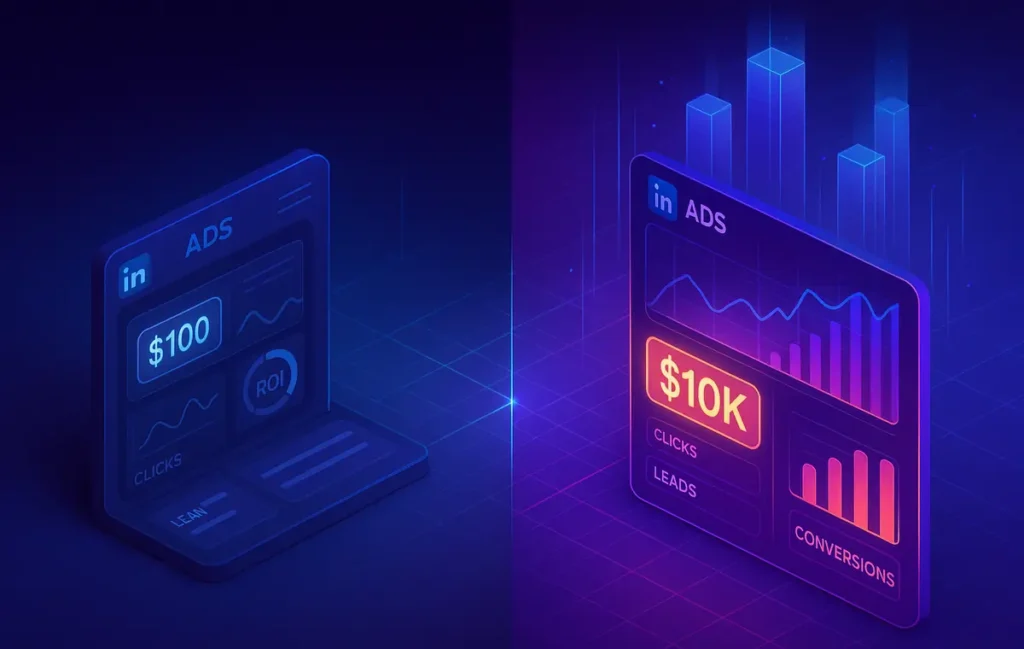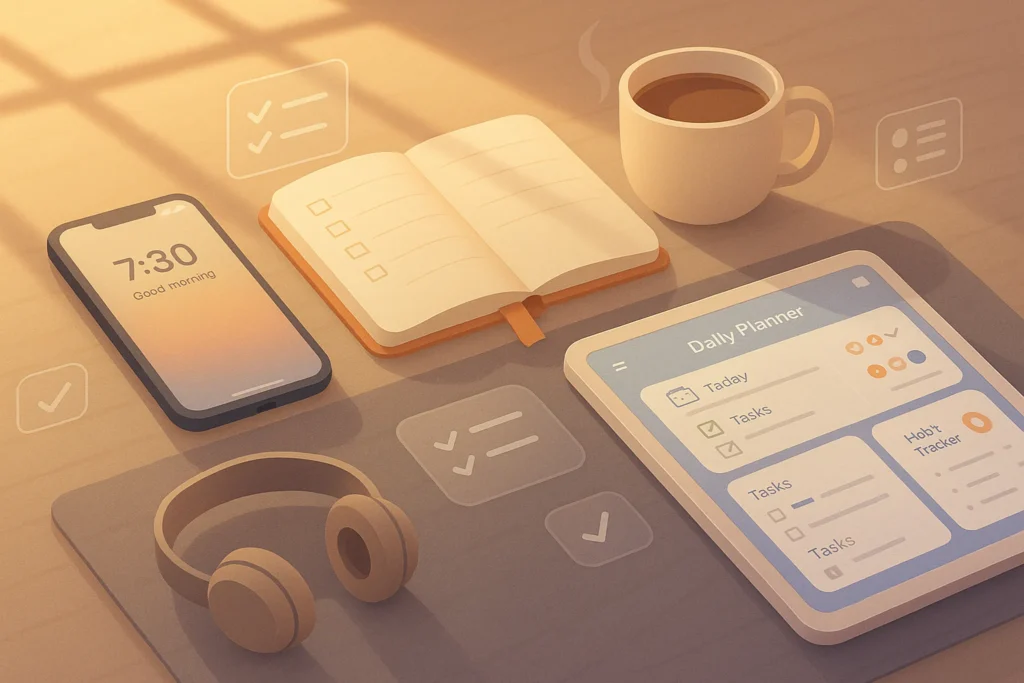🎯 Intro
“How can you go from a $100 LinkedIn Ads test to a $10,000 campaign with positive ROI?” That’s the question most B2B marketers wrestle with. Unlike Google or Facebook, LinkedIn isn’t a playground for cheap clicks—it’s a premium platform where decision-makers live. The cost per click may sting at first, but the potential return is unmatched if you know how to test, optimize, and scale systematically.
At NerdChips, we’ve seen small businesses and startups hesitate at the $10+ CPC price tag, only to later realize that one good lead from LinkedIn is often worth ten from other channels. Scaling LinkedIn Ads is a game of patience, precision, and data—not guesswork.
🔍 Why LinkedIn Ads Are Unique
LinkedIn Ads stand apart because of who you can reach. While Facebook and Google Ads cast wider nets, LinkedIn lets you zero in on professionals by job title, industry, and even company size. This precision comes at a price: CPCs average 2–3x higher than other platforms. But the trade-off is lead quality.
If your product is aimed at B2B buyers, consultants, or high-ticket SaaS users, LinkedIn delivers audiences that convert faster and stay longer. You’re not just running ads—you’re building credibility in a professional ecosystem.
The targeting granularity also means you can avoid wasted impressions. Instead of “interest in marketing,” you can go after “CMOs in mid-sized tech companies.” This level of intent targeting is why LinkedIn is expensive but worth it. Compared to campaigns we analyzed for Social Media Marketing or AI-Powered Marketing strategies, LinkedIn is less about volume and more about laser focus.
💡 Nerd Tip: LinkedIn Ads aren’t for everyone. They work best when customer lifetime value justifies the higher upfront acquisition cost.
⚡ The $100 Test Phase
Scaling starts with a test budget. A $100 test won’t give you full data, but it provides a signal. Think of it as dipping your toe in the water.
In this phase, focus on testing ad formats (single image, carousel, video), copy variations, and targeting segments. Don’t waste energy trying to prove ROI yet—use these micro-budgets to measure engagement, CTR, and lead form completion.
One early-stage SaaS ran three ads with just $100: one video, one text ad, and one carousel. The carousel generated 4x the CTR. That insight alone informed how they built the next $1,000 test.
To keep things structured, document every variable. Which audience clicked more? Which CTA resonated? Was “Download Guide” stronger than “Book Demo”? Without this clarity, scaling will only multiply inefficiencies.
📈 Scaling to $1K, $5K, and $10K
Once your $100 test shows promise, you’re ready for the $1K stage. The goal here is validation—prove that results from your micro-test hold at scale.
At $1K, maintain campaign structure by segmenting audiences and ad formats into separate campaigns. This lets you track ROI per variant. If one audience delivers leads at $100 each while another sits at $300, you’ll know where to double down.
The leap to $5K is about optimization. Introduce A/B testing for creative elements, test frequency caps to prevent fatigue, and refine bid strategies (manual vs. automated bidding). LinkedIn’s Campaign Manager provides deeper insights at this level, but pairing it with CRM data ensures attribution accuracy. This is where integration matters—similar to the principles in CRM vs. Marketing Automation.
At $10K, scaling isn’t just about adding budget. It’s about systematizing. Creative refreshes every 2–3 weeks prevent fatigue. Retargeting campaigns capture warmer leads. Analytics tools help you identify true ROI rather than surface-level metrics.
💡 Nerd Tip: Scaling without attribution is gambling. Set up UTM tracking and CRM integrations from day one so you know which dollar generated which lead.
🛠️ Tools & Tactics
Scaling LinkedIn Ads requires both platform-native tools and external integrations. LinkedIn Campaign Manager is your command center, but it needs reinforcement. Integrating with a CRM (whether HubSpot, Zoho, or lightweight alternatives) ensures leads don’t disappear into spreadsheets.
Analytics platforms close the loop on ROI. Pair Campaign Manager with Google Analytics or a dedicated attribution tool to see which campaigns create not just clicks but revenue. Many SMBs have found success linking LinkedIn campaigns with content workflows powered by Content Marketing Platforms—ensuring ad traffic is funneled into high-value assets like whitepapers, guides, or AI-driven reports.
And don’t forget AI tools. Some brands use predictive algorithms to identify high-probability buyers from their LinkedIn data. This complements tactics already outlined in 10 Best AI Marketing Tools for Small Businesses, showing how artificial intelligence can amplify human strategy.
⚡ Scale Campaigns with the Right Tools
Pair LinkedIn Campaign Manager with CRM and analytics integrations to see true ROI. Add AI tools to sharpen targeting and scale smarter.
🚀 Case Study
Let’s consider a mid-sized SaaS company selling project management software. They began with a $100 test campaign targeting operations managers in North America. Their CTR hovered at 0.6%, below benchmark, but video ads with customer testimonials performed best.
With those insights, they scaled to $1K, focusing on testimonial videos and narrowing targeting to 5,000 accounts. This brought lead costs down from $250 to $150. At $5K, they layered retargeting and refreshed creatives biweekly. Finally, at $10K, they integrated with their CRM and analytics stack, proving that each $150 lead was converting into an average $5,000 ARR contract.
The result? ROI-positive campaigns where $10K spend generated over $200K in new pipeline. That’s the LinkedIn advantage: high cost per click, but outsized payoff when structured well.
⚠️ Challenges & Solutions
High CPCs: LinkedIn clicks are expensive. The solution is to narrow targeting to only high-value segments and use retargeting to stretch ROI.
Creative Fatigue: Ads burn out fast on LinkedIn. Refresh creative every 2–3 weeks to avoid declining CTRs.
Attribution Gaps: Without CRM integration, you’ll never know if clicks became contracts. Solve this with tight UTM structures and analytics integrations.
📊 Benchmarks & Industry Data
When scaling LinkedIn Ads, benchmarks help you understand whether your performance is above or below average. Across industries, LinkedIn’s average click-through rate (CTR) hovers between 0.4%–0.65%, which is lower than Facebook’s average CTR of 0.9%. But here’s the catch: conversion rates on LinkedIn are significantly higher in B2B, often in the 6–8% range when targeting is tight.
Cost-per-click (CPC) averages around $5–$8, but in niche industries like software consulting or enterprise SaaS, it can climb to $12–$15 per click. For high-ticket services, this cost is still justified—one deal can cover the ad spend for months. Knowing these numbers sets realistic expectations, so you don’t panic when you see a $9 CPC, but instead measure whether the resulting leads are qualified.
💡 Nerd Tip: Don’t compare LinkedIn CPCs with Facebook or Google. Compare them against your lead value. One $200 lead that closes is better than ten $20 leads that go nowhere.
🎨 Creative Strategy Layer
Ad performance on LinkedIn is less about flashy graphics and more about perceived authority. The platform’s audience wants thought leadership, not clickbait. That’s why testimonial videos, carousel case studies, and problem-solution explainers outperform direct product pushes.
For example, a carousel ad that walks through a three-step case study (“Challenge → Solution → Result”) can feel like free knowledge rather than an ad. Sponsored InMail works best when framed as a personal invitation to a webinar or event, not a cold pitch. Even single-image ads perform better when they lead with a bold insight rather than a discount.
The creative sweet spot is content that educates and positions your brand as a trusted advisor. This aligns with broader strategies we’ve explored in Content Marketing Platforms, where value-first messaging generates higher engagement than transactional ads.
🧠 The Psychology of LinkedIn Users
Understanding why LinkedIn users behave differently is essential for scaling campaigns. Unlike Facebook users, who are there to socialize or be entertained, LinkedIn users log in with a professional mindset. They’re looking for opportunities, connections, and insights that can improve their career or business.
This means tone matters. Messages that sound too casual or salesy often underperform. Instead, campaigns that frame themselves as educational or opportunity-driven resonate best. A headline like “How SaaS founders cut churn by 30% in 90 days” will outperform “Get our software today” because it matches the user’s intent: growth, efficiency, and professional credibility.
By respecting the psychology of the audience, your ads stop feeling like intrusions and start feeling like relevant contributions to their feed.
📋 Pre-Scaling Checklist
Before moving from micro-tests to scaled campaigns, run through this quick checklist:
-
Is your audience narrow enough to target decision-makers without burning budget?
-
Have you defined micro-KPIs for your $100 test (CTR, CPL, or demo request rate)?
-
Do you have attribution set up through UTM tracking and CRM integration?
-
Have you prepared creative variations to rotate every 2–3 weeks?
If you can answer “yes” to all four, you’re in a strong position to scale from $1K to $10K without flying blind.
🔮 Future Outlook: AI and Predictive Ads
The next wave of LinkedIn Ads will be powered by AI. Predictive analytics tools already recommend lookalike audiences and forecast which segments are most likely to convert. In the near future, creatives themselves will adapt in real time—changing images, copy, or CTAs depending on the viewer’s profile.
Imagine a decision-maker in healthcare seeing an ad framed around compliance benefits, while a CTO in SaaS sees the same ad reframed around scalability. This kind of hyper-personalization will make campaigns both more efficient and more human.
Marketers who prepare for this shift now—by understanding AI-driven targeting and attribution—will gain a competitive edge. That’s why pairing your LinkedIn Ads strategy with insights from AI-Powered Marketing ensures you’re not just keeping up, but leading.
📬 Want More Smart AI Tips Like This?
Join our free newsletter and get weekly insights on AI tools, no-code apps, and future tech—delivered straight to your inbox. No fluff. Just high-quality content for creators, founders, and future builders.
🔐 100% privacy. No noise. Just value-packed content tips from NerdChips.
🧠 Nerd Verdict
LinkedIn Ads aren’t cheap, but for B2B they can be one of the best ROI machines available. Success isn’t about spending big upfront—it’s about starting small, learning fast, and scaling step by step. Brands that track data from the $100 test all the way up to $10K campaigns don’t just generate leads—they build sustainable pipelines.
❓ FAQ: Nerds Ask, We Answer
💬 Would You Bite?
If you knew every lead from LinkedIn could return 5x your ad spend, would you start your first $100 test today?
Or would you keep watching competitors take the market share? 👇
Crafted by NerdChips for creators and teams who want their best ideas to travel the world.



